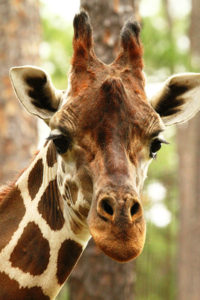
Giraffes are predominantly found in open scrub areas. The males can weigh up to 2,000 lbs, reaching 15-18 ft.; Females – 1,200 lbs, 16-17 ft. Their diet consists of leaves and shoots of trees, their favorite trees are various species of Acacia. The name Giraffe is derived from the Arabic ‘Azarafah’ (one who walks swiftly, gracefully). Giraffes have been clocked at speeds approaching 37 mph. In the walking gait, the legs on one side move forward almost simultaneously, seen elsewhere only in camels and in domestic horses trained to do so. Two of the basic types are the reticulated giraffe (after reticulum, Latin for net), and the Masai giraffe of central and southern Africa with a broken leaf pattern. There are seven neck vertebrae, as seen in most other mammals. The giraffe is equipped with a 25 lb. heart with 3″ thick ventricle walls, and pumping capacity of 16 gallons per minute. A net of capillaries (rete mirabile) absorbs the excess arterial blood pressure created when the head is lowered to drink. As the giraffe raises its head back to the normal carrying position, a series of valves in the jugular veins, slows the rush of blood from the head. The 17″ tongue and the giraffes’ superior height allow for feeding high above the competition.
Giraffes are gregarious and non-territorial, living in loosely organized groups. Females are faithful to particular calving grounds and their single offspring associate in nursery groups (creches). Vocalizations are rare, but giraffes are not mute. Calves bawl when alarmed or excited. Cows, when separated from their calves may give a roaring bellow, and courting bulls occasionally emit a loud coughing sound. People often confuse the protuberances from the top of the giraffes’ skull with horns, when in fact they are ossicones (skin covered portions of the skull). Adolescent male hierarchies are often determined by the outcome of neck sparring, the delivery of head blows to the opponent. Once supremacy has been established such bouts are amicably terminated. Breeding is perennial, gestation lasting 14-14 1/2 months. Calves have a birth weight of 100-150 lbs; and are delivered while the female is standing. Five to six feet tall at birth, calves add as much as 9 inches to their birth height in the first month and 3 additional inches per month throughout their first year, at which time the birth height has been doubled. Weaning occurs at 16 months, sexual maturity at 2-5 years, and the life span may be up to 30 years, though 25 is the average.
White Oak has had giraffes since 1987. Some subspecies of giraffe are considered endangered. Current estimates have the population of ~68,000 individuals across all (sub)species. This is a considerable drop in the last decade and shows that the plight of giraffe is in real danger. Efforts are underway to build up an accurate census of the entire population – working closely with IUCN SSC ASG International Giraffe Working Group.
